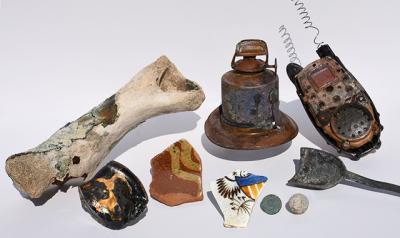History Unearthed at Havens

Havens Beach in Sag Harbor has been inadvertently transformed into an active archaeological site following last November’s dredging of a section of the bay off Long Wharf. Along with the estimated 10,000 cubic yards of sand that were pumped from the bottom of the bay onto the beach came such historical artifacts as musket balls, an oil lamp, shards of pottery and porcelain, and coins that date as far back as 1875.
Jean Held, a trustee of the Sag Harbor Historical Society, has been overseeing a collection of the discovered objects since the fall and is in the process of researching their provenances.
“It’s amazing that all this history was being dredged up,” said Ms. Held, who, having spotted the large deposits of muddy sand soon after they arrived, asked David Cosgrove — a friend who owns a metal detector — to immediately begin canvassing the area. “I had no idea where all this was going to go, not a clue,” she said.
Ms. Held happened to be with Mr. Cosgrove on the day he found musket balls, remnants of Sag Harbor’s distant past, which includes two major historical attles. During the Revolutionary War, Lt. Col. Return Jonathan Meigs led a band of soldiers from the Continental Army in a raid to retake the village, which had been seized by British forces. “Meigs came over and captured all the British soldiers who were quartered at the Howell Inn, which is where the American Hotel is today,” said Jack Youngs, the president of the historical society. “They came in whaleboats and burned all the supplies and left with captive British soldiers. Not one patriot was killed.” The second battle came during the War of 1812 when, Mr. Youngs said, the British tried to invade Sag Harbor but were repelled by soldiers stationed at a fort on Turkey Hill. “At that time, you could see the whole bay area from there,” he said.
“The story will be, why is all this stuff around the wharf?” asked Ms. Held.
To begin the process of answering that question and pinpointing the histories of the items, she has filled more than 20 containers with a diverse assortment of objects — including what, to her eye, look to be a pig’s bone and a cow’s tooth — that have been found by Mr. Cosgrove and others. “We have a giant collection of big rusty nails,” she said, pointing to two jars, one of which contains square-cut nails, which likely date to the 1800s. A wick turner from an oil lamp has its manufacturer’s name marked on it, which allowed Ms. Held, in a preliminary review, to trace it back to the late 1800s or early 1900s. Some of the items, such as a battered walkie-talkie, and a tiny Tonka truck that had fused with a rock, had been lost at sea more recently. By visiting the Tonka company’s website, she deduced that the toy was made between the 1950s and the 1970s. One treasure that got away: a cannonball that Ms. Held heard had been retrieved by a fellow scavenger.
“Most of the things David found were metal, but he also found pieces of pottery,” said Ms. Held. To gauge the historical significance of the pottery shards, she consulted with Dorothy Zaykowski, a fourth-generation resident who is the author of “Sag Harbor: The Story of an American Beauty.” According to Ms. Zaykowski, the most fascinating finds are what’s known as “redware,” utilitarian pottery made from red clay, which, according to her research books, also dated to the 1800s. “It was something Americans could make so they didn’t have to buy from the British,” said Ms. Held. “It was cheap to make, you didn’t have to fire it at such a high temperature, it was made with local clay, and they painted them very primitively.”
Other potentially historical discoveries include a Queen Anne-style spoon that features a ridge known as a “rat’s tail” along the length of its underside, and a jagged center section of a porcelain plate emblazoned with the Great Seal of the United States.
Earlier this year, after receiving complaints about baseball-size rocks that had accumulated on the beach following the dredging, the village hired a company to sift the sand. As part of that process, “they dumped all the rocks into one place near the beach, which was a godsend,” said Ms. Held. Among the pieces retrieved from that rock pile, Ms. Zaykowski found a portion of a Whistle soda bottle, the container of an orange soft drink made by the Sag Harbor-based Wilson Bottling company between 1895 and 1897.
As recently as last week, Ms. Held discovered a piece of glass in the sand that she believes was made in the early-20th century. She added it to her extensive collection of sea glass. In an attempt to uncover the backstory of one particular piece of black sea glass, she consulted with George Fisher, a bottle expert, who thought it might date to the 1700s. “The beauty of black sea glass is not only its color, it’s also its rarity and its historical significance,” said Ms. Held. “Most black shards are found in the Caribbean and other sites where the liquor trade was common during the 18th and 19th centuries.”
“I’m learning as I go along,” said Ms. Held, who, once she’s past the discovery stage, plans to enlist the aid of local historians in the research process. She is also seeking help from residents both in identifying found items and scrutinizing the beach for those yet to be unearthed. “Low tide is approaching,” she said.
